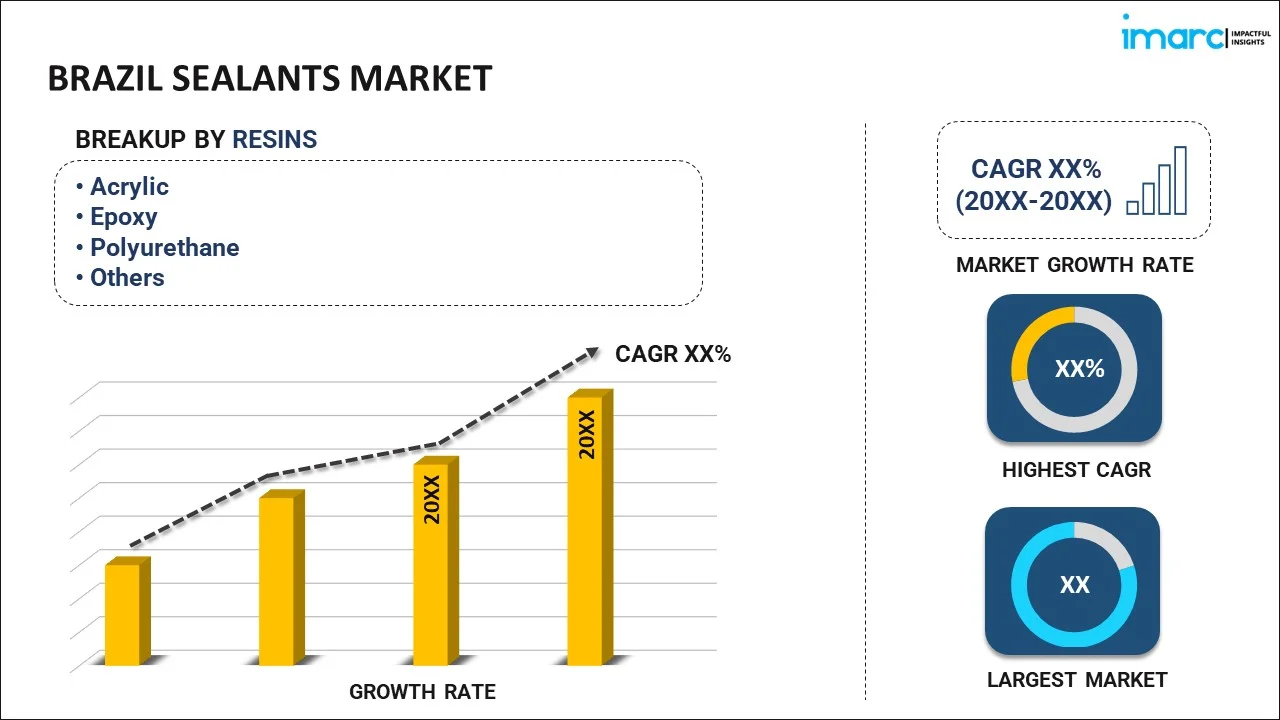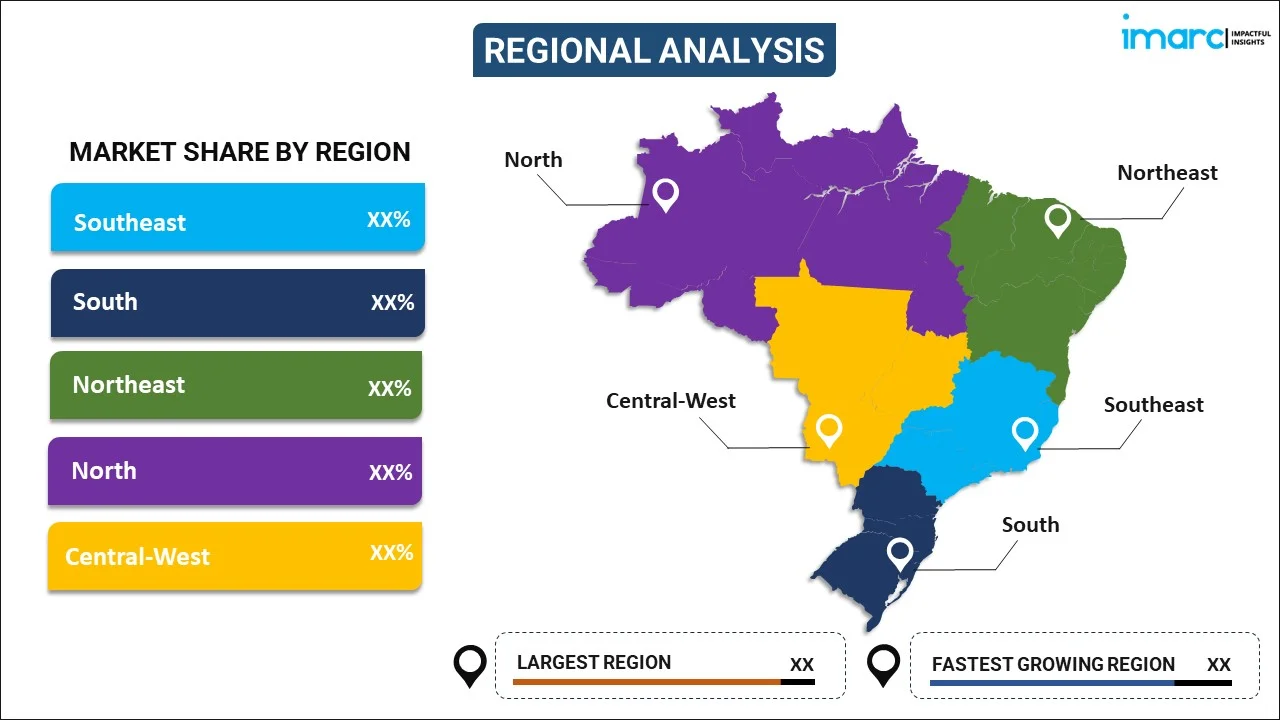
Brazil Sealants Market Report by Resin (Acrylic, Epoxy, Polyurethane, Silicone, and Others), End User (Aerospace, Automotive, Building and Construction, Healthcare, and Others), and Region 2024-2032
Market Overview:
Brazil sealants market size is projected to exhibit a growth rate (CAGR) of 5.72% during 2024-2032. The increasing construction and infrastructure activities, the rapid urbanization, the rising product use in the automotive industry in vehicle assembly and manufacturing processes, and the widespread product applications in the electronics and electrical sectors for applications like potting, encapsulation, and bonding are some of the key factors propelling the market.
|
Report Attribute
|
Key Statistics
|
|---|---|
|
Base Year
|
2023 |
|
Forecast Years
|
2024-2032 |
|
Historical Years
|
2018-2023
|
| Market Growth Rate (2024-2032) | 5.72% |
Sealants are versatile materials designed to fill gaps, joints, and crevices, providing a protective barrier against environmental factors such as moisture, air, dust, and sound. Comprising polymers, silicone, polyurethane, or other specialized compounds, sealants are applied in a liquid or semi-liquid state and cured to form a flexible, durable, and impermeable seal. Their primary purpose is to prevent the ingress of external elements into structures, ensuring integrity, longevity, and enhanced performance. Sealants find extensive use in various industries, including construction, automotive manufacturing, electronics, and consumer goods. In construction, sealants are employed for weatherproofing, bonding, and sealing joints in buildings, bridges, and infrastructure projects. In the automotive industry, sealants contribute to vehicle assembly, providing adhesive strength and sealing against environmental elements. Additionally, sealants are crucial in the electronics sector, protecting delicate components from moisture and contaminants. As versatile and adaptable materials, sealants are indispensable in maintaining structural integrity, energy efficiency, and the quality and durability of diverse products and structures across numerous applications and industries.
Brazil Sealants Market Trends:
The market in Brazil is majorly driven by the growth of the construction industry, characterized by infrastructure development and urbanization. Sealants play a pivotal role in the construction sector, providing weatherproofing, joint sealing, and bonding solutions, ensuring the longevity and durability of structures. Furthermore, the automotive industry significantly contributes to the market. As vehicle manufacturing advances, sealants are essential for body assembly, glazing, and under-the-hood bonding applications. With the growing demand for lightweight and fuel-efficient vehicles, sealants that contribute to structural integrity without adding weight are increasingly adopted. Moreover, the expansion of the electronics and electrical industry is fueling the market growth. Sealants protect electronic components from environmental factors such as moisture, dust, and chemicals. The growth of electronic devices and the demand for durable and reliable sealing solutions are providing a boost to the adoption of specialized sealants in this sector. Additionally, the rising emphasis on sustainability and energy efficiency in construction practices is propelling the demand for sealants that contribute to better insulation and reduced energy consumption. As green building initiatives gain momentum, sealants that enhance the energy efficiency of structures become integral to sustainable construction projects, thereby stimulating the market. Also, the expanding renewable energy sector, including solar and wind projects, is contributing to the demand for sealants. These sealants ensure solar panels' and wind turbine installations' long-term performance and weather resistance. Besides, the escalating awareness of the importance of air quality and soundproofing in buildings is driving the demand for sealants that provide effective air and acoustic sealing. As consumers and industries prioritize healthier indoor environments and reduced noise pollution, it is resulting in higher product adoption.
Brazil Sealants Market Segmentation:
IMARC Group provides an analysis of the key trends in each segment of the market, along with forecasts at the country level for 2024-2032. Our report has categorized the market based on resin and end user.
Resin Insights:

- Acrylic
- Epoxy
- Polyurethane
- Silicon
- Others
The report has provided a detailed breakup and analysis of the market based on the resin. This includes acrylic, epoxy, polyurethane, silicon, and others.
End User Insights:
- Aerospace
- Automotive
- Building and Construction
- Healthcare
- Others
A detailed breakup and analysis of the market based on the end user have also been provided in the report. This includes aerospace, automotive, building and construction, healthcare, and others.
Regional Insights:

- Southeast
- South
- Northeast
- North
- Central-West
The report has also provided a comprehensive analysis of all the major regional markets, which include Southeast, South, Northeast, North, and Central-West.
Competitive Landscape:
The market research report has also provided a comprehensive analysis of the competitive landscape in the market. Competitive analysis such as market structure, key player positioning, top winning strategies, competitive dashboard, and company evaluation quadrant has been covered in the report. Also, detailed profiles of all major companies have been provided.
Brazil Sealants Market Report Coverage:
| Report Features | Details |
|---|---|
| Base Year of the Analysis | 2023 |
| Historical Period | 2018-2023 |
| Forecast Period | 2024-2032 |
| Units | US$ Million |
| Scope of the Report | Exploration of Historical Trends and Market Outlook, Industry Catalysts and Challenges, Segment-Wise Historical and Future Market Assessment:
|
| Resins Covered | Acrylic, Epoxy, Polyurethane, Silicone, Others |
| End Users Covered | Aerospace, Automotive, Building and Construction, Healthcare, Others |
| Regions Covered | Southeast, South, Northeast, North, Central-West |
| Customization Scope | 10% Free Customization |
| Report Price and Purchase Option | Single User License: US$ 3699 Five User License: US$ 4699 Corporate License: US$ 5699 |
| Post-Sale Analyst Support | 10-12 Weeks |
| Delivery Format | PDF and Excel through Email (We can also provide the editable version of the report in PPT/Word format on special request) |
Key Questions Answered in This Report:
- How has the Brazil sealants market performed so far and how will it perform in the coming years?
- What has been the impact of COVID-19 on the Brazil sealants market?
- What is the breakup of the Brazil sealants market on the basis of resin?
- What is the breakup of the Brazil sealants market on the basis of end user?
- What are the various stages in the value chain of the Brazil sealants market?
- What are the key driving factors and challenges in the Brazil sealants?
- What is the structure of the Brazil sealants market and who are the key players?
- What is the degree of competition in the Brazil sealants market?
Key Benefits for Stakeholders:
- IMARC’s industry report offers a comprehensive quantitative analysis of various market segments, historical and current market trends, market forecasts, and dynamics of the Brazil sealants market from 2018-2032.
- The research report provides the latest information on the market drivers, challenges, and opportunities in the Brazil sealants market.
- Porter's five forces analysis assist stakeholders in assessing the impact of new entrants, competitive rivalry, supplier power, buyer power, and the threat of substitution. It helps stakeholders to analyze the level of competition within the Brazil sealants industry and its attractiveness.
- Competitive landscape allows stakeholders to understand their competitive environment and provides an insight into the current positions of key players in the market.
Need more help?
- Speak to our experienced analysts for insights on the current market scenarios.
- Include additional segments and countries to customize the report as per your requirement.
- Gain an unparalleled competitive advantage in your domain by understanding how to utilize the report and positively impacting your operations and revenue.
- For further assistance, please connect with our analysts.
 Inquire Before Buying
Inquire Before Buying
 Speak to an Analyst
Speak to an Analyst
 Request Brochure
Request Brochure
 Request Customization
Request Customization




.webp)




.webp)












